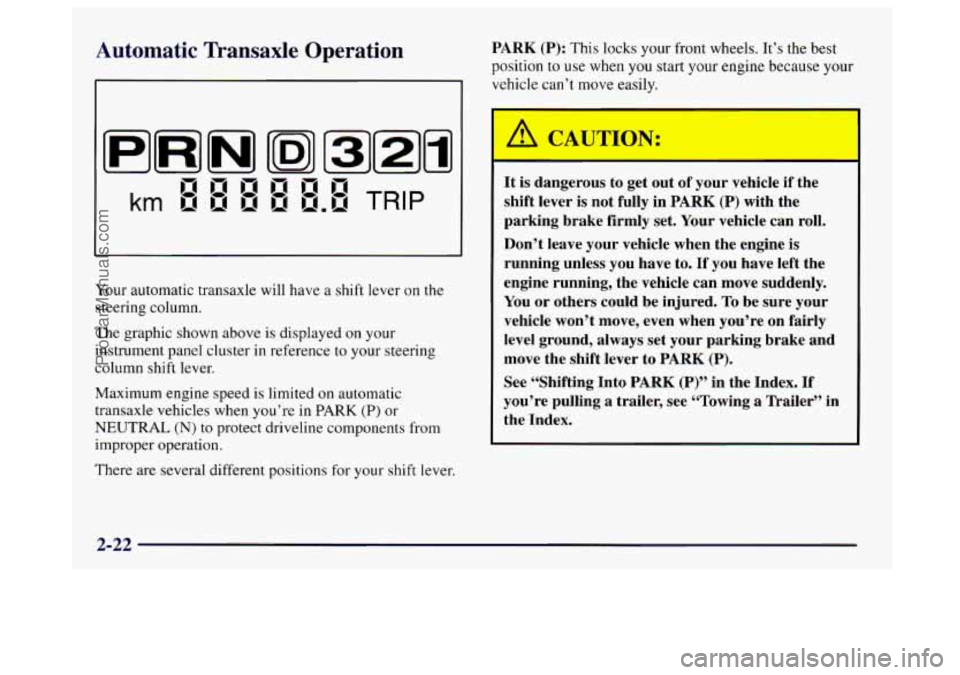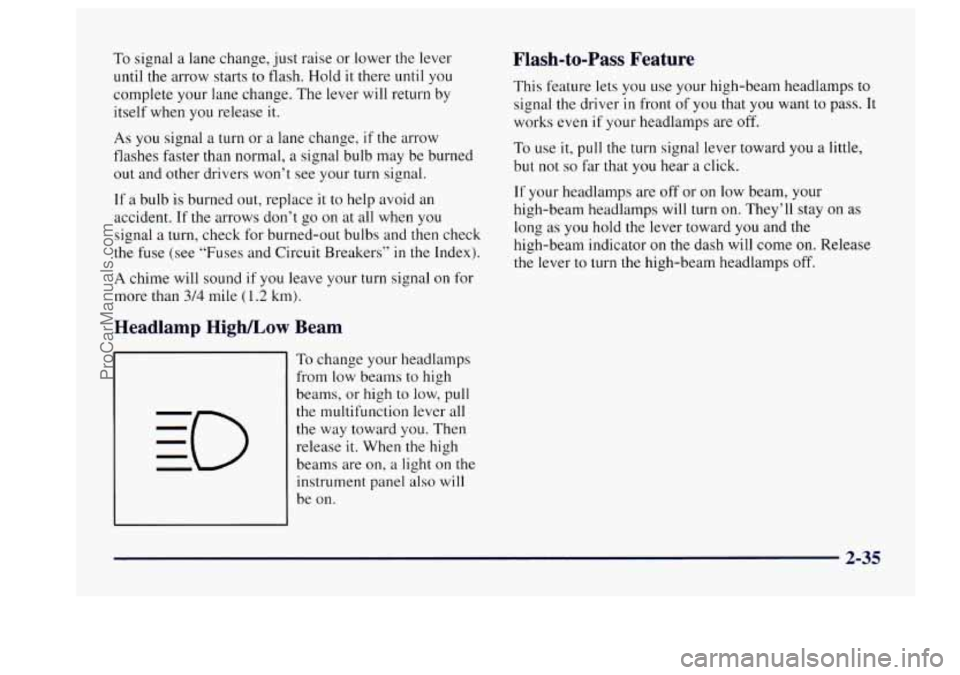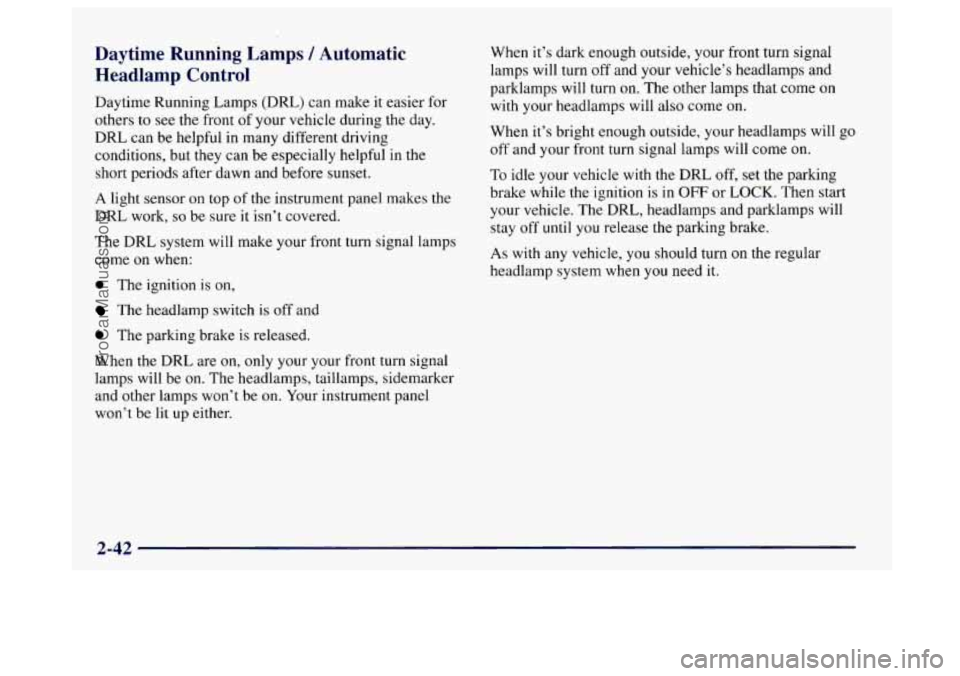Page 98 of 406

Automatic Transaxle Operation PARK (P): This locks your front wheels. It’s the best
position to use when you start your engine because your
vehicle can’t move easily.
Your automatic transaxle will have
a shift lever on the
steering column.
The graphic shown above is displayed on your
instrument panel cluster
in reference to your steering
column shift lever.
Maximum engine speed is limited on automatic
transaxle vehicles when you’re in
PARK (P) or
NEUTRAL (N) to protect driveline components from
improper operation.
There are several different positions for your shift lever.
L
CAUTIO,. :
It is dangerous to get out of your vehicle if the
shift lever is not fully in
PARK (P) with the
parking brake firmly set. Your vehicle can roll.
Don’t leave your vehicle when the engine is
running unless you have
to. If you have left the
engine running, the vehicle
can move suddenly.
You or others could be injured. To be sure your
vehicle won’t move, even when you’re on fairly
level ground, always set your parking brake and
move the shift lever to
PARK (P).
See “Shifting Into PARK (P)” in the Index. If
you’re pulling a trailer, see “Towing a Trailer” in
the Index.
2-22
ProCarManuals.com
Page 110 of 406
Turn SignaUMultifunction Lever
L
Lr
The lever on the left side of the steering column
includes your:
Turn Signal and Lane Change Indicator
0 Headlamp HighLow Beam
Windshield Wipers
0 Windshield Washer
0 Cruise Control
0 Flash-to-Pass
Turn Signal and Lane Change Indicator
The turn signal has two upward (for right) and two
downward (for left) positions. These positions allow
you
to signal a turn or a lane change.
To signal a turn, move the lever all the way up or down.
When the
turn is finished, the lever will return automatically.
An arrow on the instrument
panel will flash in the
direction of the turn
or
lane change.
2-34
ProCarManuals.com
Page 111 of 406

To signal a lane change, just raise or lower the lever
until the arrow starts
to flash. Hold it there until you
complete your lane change. The lever will return by
itself when you release
it.
As you signal a turn or a lane change, if the arrow
flashes faster than normal, a signal bulb may be burned
out and other drivers won’t see your turn signal.
If a bulb is burned out, replace it to help avoid an
accident. If
the arrows don’t go on at all when you
signal a turn, check for burned-out bulbs and then check
the fuse (see “Fuses and Circuit Breakers’’
in the Index).
A chime will sound if you leave your turn signal on for
more than
3/4 mile (1.2 km).
Headlamp High/Low Beam
To change your headlamps
from low beams to high
beams, or high
to low, pull
the multifunction lever all
the way toward you. Then
release
it. When the high
beams are on, a light on
the
instrument panel also will
be on.
Flash-to-Pass Feature
This feature lets you use your high-beam headlamps to
signal the driver in front of you that you want to pass. It
works even if your headlamps are
off.
To use it, pull the turn signal lever toward you a little,
but not
so far that you hear a click.
If your headlamps are off or on low beam, your
high-beam headlamps will turn
on. They’ll stay on as
long as you hold the lever toward you and the
high-beam indicator
on the dash will come on. Release
the lever to turn the high-beam headlamps off.
2-35
ProCarManuals.com
Page 113 of 406
Windshield Washer
At the top of the multifunction lever, there’s a paddle with
the word
PUSH on it. To spray washer fluid on the
windshield, push the paddle. The wipers will run
for
several sweeps and then either stop or return to your preset
speed. See “Windshield Washer Fluid” in the Index.
LOW WASH
The LOW WASH light on
your instrument panel
cluster will glow when the
fluid level
is low.
I
In freezlng weather, don’t use your washer until
the windshield is warmed. Otherwise the washer
fluid can form ice
on the windshield, blocking
your vision.
Cruise Control (Option)
With cruise control, you can maintain a speed of about
25 mph (40 km/h) or more without keeping your foot on
the accelerator. This can really help
on long trips. Cruise
control does
not work at speeds below about 25 mph
(40 km/h).
2-37
ProCarManuals.com
Page 114 of 406
When you apply your brakes, the cruise control
shuts
off.
/tl CAC LION:
Setting Cruise Control
Cruise control can be dangerous where you
can't
drive safely at a steady speed. So,
don't use your cruise control on winding
roads or in heavy traffic.
slippery roads. On such roads, fast changes
in tire traction can cause needless wheel
spinning,
and you could lose control. Don't
use cruise control on slippery roads.
Cruise control can be dangerous on
A CAUTION:
If you leave your cruise control switch on when
you're not using cruise, you might hit a button
and
go into cruise when you don't want to. You
could
be startled and even lose control. Keep the
cruise control switch
off until you want to use it.
1. Move the cruise control switch to ON.
2. Get up to the speed you want.
3. Push in the SETKOAST
button at the end
of the
lever
and release it. The
CRUISE light on the
instrument panel will
come on.
'1 1
4. Take your foot off the accelerator pedal.
2-38
ProCarManuals.com
Page 117 of 406
Exterior Lamps
The lamp controls are located on the instrument panel.
They control these systems:
Headlamps
Taillamps
0 Parklamps
0 License Lamps
0 Sidemarker Lamps
0 Instrument Panel Lamps
0 Courtesy Lamps If you
pull the knob out
halfway,
it will turn on only
your parklamps.
If you pull
the knob all the way
out,
your headlamps will then
come on.
Push the knob
in all the way to turn off the lamps.
A warning chime will sound if you open the driver’s
door when
you turn the ignition switch to OFF, LOCK
or ACC with the lamps on.
2-41
ProCarManuals.com
Page 118 of 406

Daytime Running Lamps / Automatic
Headlamp Control
Daytime Running Lamps (DRL) can make it easier for
others to see the front
of your vehicle during the day.
DRL can be helpful
in many different driving
conditions, but
they can be especially helpful in the
short periods after dawn and before sunset.
A light sensor on top of the instrument panel makes the
DRL work,
so be sure it isn’t covered.
The DRL system
will make your front turn signal lamps
come on when:
0 The ignition is on,
The headlamp switch is off and
0 The parking brake is released.
When the DRL are on, only your your front turn signal
lamps will be on. The headlamps, taillamps, sidemarker
and other lamps won’t be
on. Your instrument panel
won’t be lit up either. When it’s
dark enough outside, your front turn signal
lamps will turn off and your vehicle’s headlamps and
parklamps will turn on. The other lamps that come on
with your headlamps will also come on.
When it’s bright enough outside, your headlamps will go
off and your front turn signal lamps will come on.
To idle your vehicle with the DRL off, set the parking
brake while the ignition is in
OFF or LOCK. Then start
your vehicle. The DRL, headlamps and parklamps will
stay off
until you release the parking brake.
As with any vehicle, you should turn on the regular
headlamp system when you need
it.
2-42
ProCarManuals.com
Page 120 of 406

Interior Lamps
Instrument Panel Brightness Control
You can brighten or dim the instrument panel lights by
moving the LIGHTS dial.
If you turn the dial past
MAX, your courtesy or interior lamps will come on.
Courtesy Lamps
When any door is opened, several lamps come on. These
lamps are courtesy lamps. They make it easy for you to
enter and leave your vehicle.
You can also turn these
lamps
on by moving the interior lamps dial all the way
to the right.
Illuminated Entry
Your courtesy lamps will come on and stay on for a set
time whenever you press UNLOCK on the remote
keyless entry transmitter.
If you open a door, the lamps will stay on while it’s open
and then turn
off automatically about 25 seconds after
you close it. If you press UNLOCK and don’t open a
door, the lamps will turn off after about 40 seconds.
Illuminated Entry includes
a feature called theater
dimming. With theater dimming, the lamps don’t just
turn off at the end of the delay time. Instead, they slowly dim after the delay time until they go out. The delay
time
is canceled if you turn the ignition key to RUN or
START,
so the lamps will dim right away.
When the ignition is on, Illuminated Entry is inactive,
which means the courtesy lamps won’t come on unless a
door is opened.
Delayed Entry Lighting
Delayed Entry Lighting illuminates your vehicle’s
interior for
a period of time after all the doors have been
closed.
The ignition must be off for Delayed Entry Lighting
to
work. Just after all the doors have been closed, the
Delayed Entry Lighting feature will continue to
work until:
0 The ignition is turned to the RUN position.
The doors are locked.
An illumination period of 25 seconds has elapsed.
If during
the illumination period a door is opened, the
timed illumination period will be canceled and the interior lamps will remain on since a door is open.
2-44
ProCarManuals.com